The Lenovo ThinkPhone by Motorola is a welcome surprise. It’s aimed at corporate types with a PC, especially if it’s a ThinkPad. I’m not a business executive, nor do I own a PC, and yet after testing it for a few weeks, the ThinkPhone has become my favorite Motorola smartphone in years. And as the Tyler Perry-esque name suggests, the phone is made by Motorola and its parent company, Lenovo.
The ThinkPhone has personality, unlike many Motorola phones in the past few years. It’s more than just a bunch of tech specs voted on by marketing research participants and packaged together at a low price. And with phones, like dogs and pigs, personality goes a long way. The ThinkPhone is reminiscent of 2017-’20 era Motorola designs that made me appreciate how much value a Moto phone can pack compared to devices from Google, Samsung and, at the time, LG.
At $700 (which converts roughly to 565, AU$1,060), the Lenovo ThinkPhone is an incredible value. It has a Snapdragon 8 Plus Gen 1 chip, (which feels speedy despite being a generation old), a 5,000-mAh battery, 68-watt fast charging (with an included power brick) and a lovely 6.6-inch 144Hz display, all wrapped in the Lenovo ThinkPad’s pinstriped and refined aesthetic.
Advertiser Disclosure
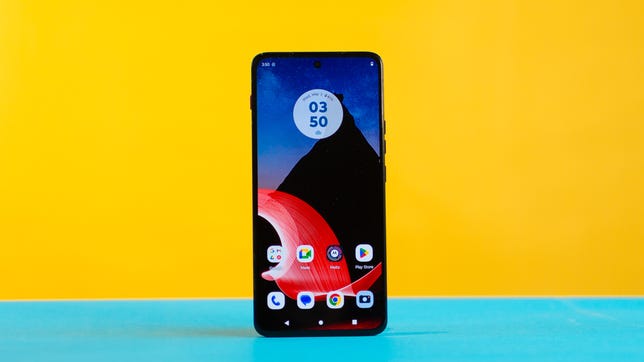
Lenovo ThinkPhone by Motorola
Like
- Cohesive design
- Incredibly fast charging
- Cross functionality with PCs
- Incredible value for the price
Don’t like
- The cameras are good, but struggle in low light
- The Google Pixel 7 is $100 less
It runs Android 13 and has a number of nifty shortcuts and cross-platform utilities with Windows. The cross functionality isn’t limited to Lenovo ThinkPads. In fact, the ThinkPhone can work with most Windows computers released in the last few years.
The phone was first announced at CES earlier this year and sells unlocked on Motorola’s website as well as Lenono’s site and B2B enterprise sales channels. Perhaps the ThinkPhone’s biggest drawback is that the $600 Pixel 7 exists. While the ThinkPhone beats the Pixel 7 in most aspects, it lacks Google’s head-of-the-class computational photo processing and lower price. To be fair, a Pixel 7 with 256GB of storage (which matches what’s on the ThinkPhone) costs $700. And that tips things in Motorola’s favor.
Lenovo ThinkPhone design and performance
The ThinkPhone has a similar design as Lenovo’s popular ThinkPad laptop line, down to the signature red button. For a new phone that’s likely the first in a new product line, the design feels refined and mature; mimicking the ThinkPad’s corporate look. There’s even a ThinkPhone by Motorola badge on the back that’s identical to the ThinkPad logo. The diagonal aramid fiber weave inlay on the back gives the smartphone a sophisticated look and feels great in hand.
The phone is rated IP68 for water and dust resistance and can survive being submerged in 1.5 meters of water for 30 minutes; about 5 feet. But don’t worry, it also comes with a case.
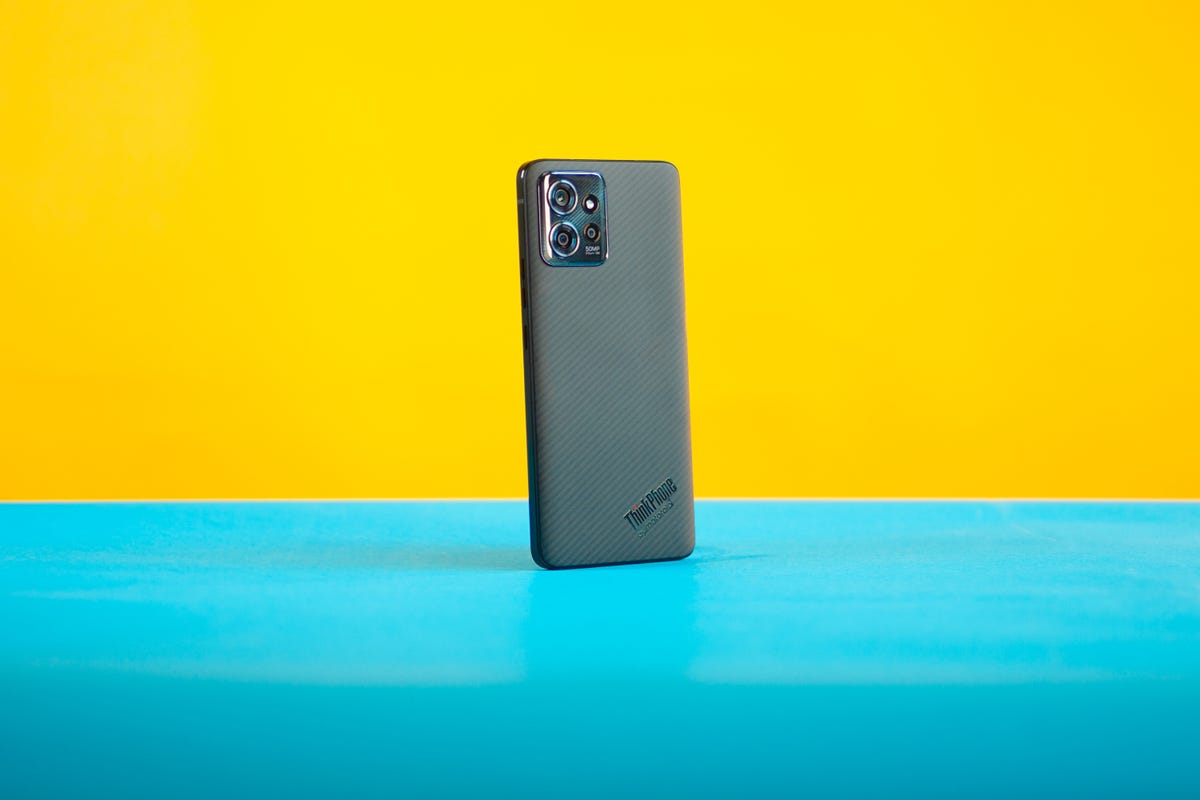
The ThinkPhone has an aluminum body, and the rear is covered in aramid fiber.
The 6.6-inch display looks good, even under bright light. Its refresh rate can go up to 144Hz. What I did is leave it on “auto,” which switches the refresh rate by up to 120Hz depending on what’s on your screen. Under the screen is an optical fingerprint reader, which worked well.
The phone runs last year’s Snapdragon chip instead of the newer Snapdragon 8 Gen 2 chip found in the OnePlus 11 or Galaxy S23. And to be precise, it’s the plus variant that debuted last summer. It’s a savvy way to balance powerful performance and excellent efficiency while keeping the price down. I wish more companies would use last year’s premium processor to help lower the cost. In fact, Motorola’s upcoming Razr Plus runs on the same chip, which I’m certain helps keep its price down.
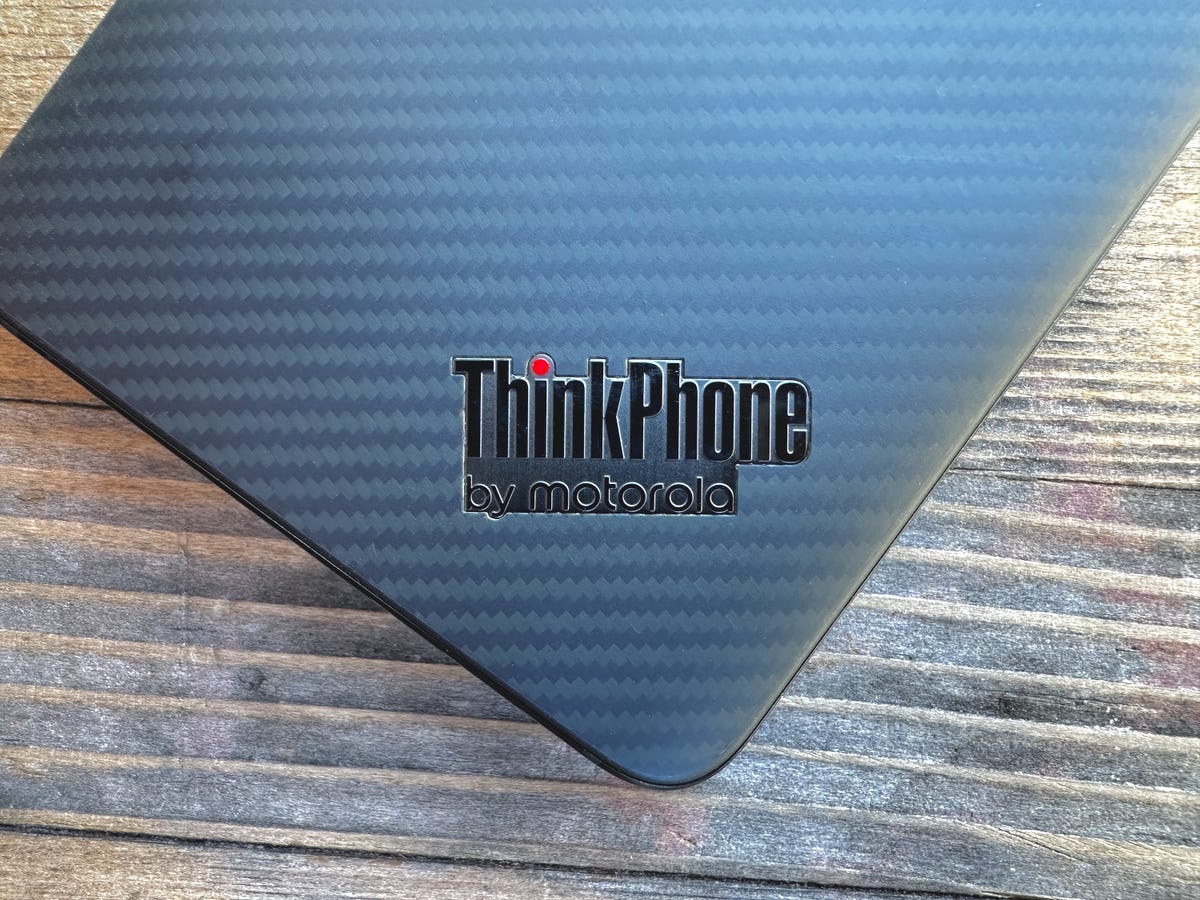
The back of the phone comes with the same bottom corner branding as a Lenovo ThinkPad.
Essentially, this is a Motorola phone that runs on a close-to-stock version of Android 13 with a few enhancements like Moto UX, shortcuts and features like GameTime, a mode that minimizes distractions during game play. It has Microsoft Office preinstalled and that’s where that red button on the side seems most at home. I can use the button with Microsoft Teams’ push to talk feature or program it for another shortcut. It’s a lovely addition that makes the phone more unique than its Motorola Edge cousins. I used the button to trigger the audio recorder app.
Performance was generally fast and smooth, aside from one minor “bug” I found during my testing. When I rotated the phone between a horizontal and vertical position, occasionally content stayed in landscape even though the ThinkPhone was vertical. (And no, the orientation lock wasn’t on.)
The ThinkPhone handled gaming well when I played titles like PUBG Mobile, Super Mario Run, Alto’s Odyssey and Genshin Impact, especially in Motorola’s nifty GameTime mode. Remember the phone’s Snapdragon 8 Plus Gen 1 chip is the same one that debuted on last year’s Asus ROG Phone 6.
Geekbench V.5.0 Single-core
Geekbench V.5.0 Multicore
Everyday tasks were peppy, as were running Motorola’s Ready For connectivity tools, some of which have been repackaged as Think 2 Think (get it?) to connect to PCs, monitors and TVs. For example, I copied and pasted text and photos from the phone to a ThinkPad laptop and used the ThinkPhone’s 50-megapixel main rear camera for a video call I took on the ThinkPad. The image looked good.
I was also able to pull up the ThinkPhone’s screen on a ThinkPad. There was the occasional lag but overall it worked OK. I can’t think of when I’d want my phone’s display to appear on my laptop or what I’d use that for exactly.
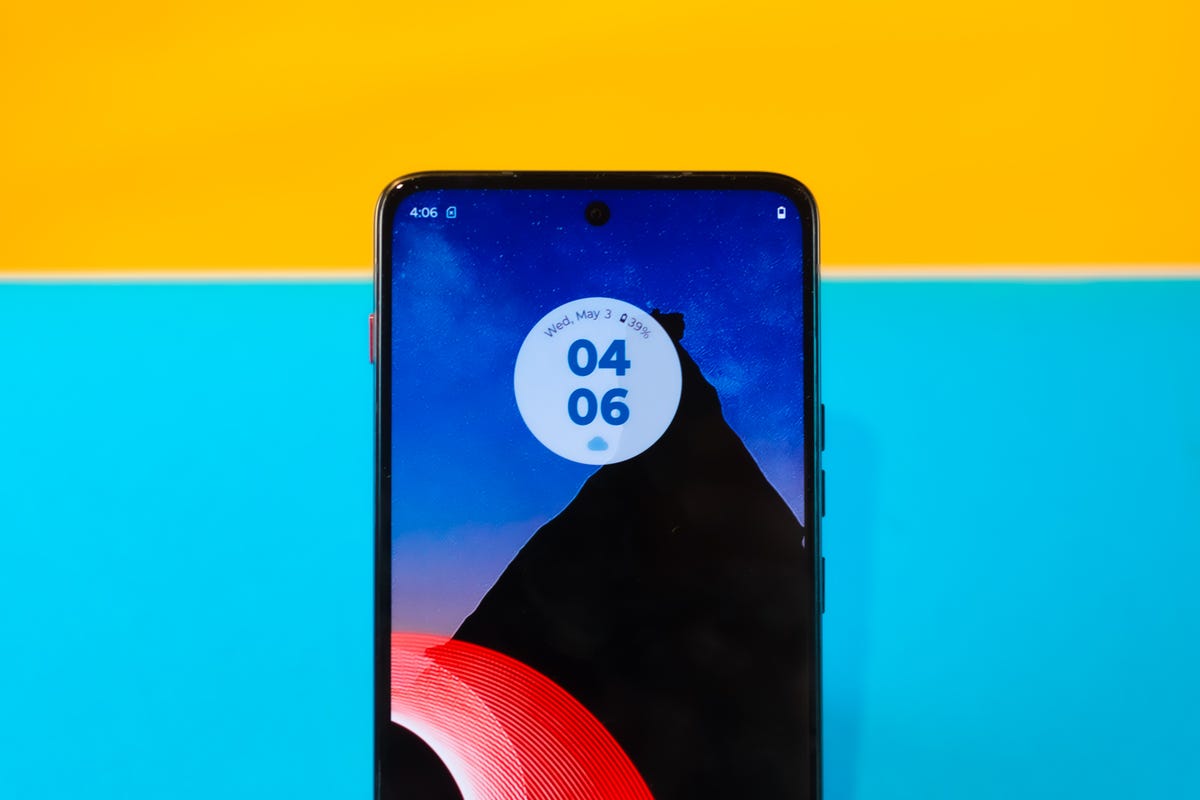
The ThinkPhone’s software is very similar to other Motorola phones aside from several Lenovo features.
Like most Motorola devices, the ThinkPhone has Lenovo’s ThinkShield, which helps with data privacy. There are also utilities for remote management that are obviously aimed at a company’s IT team. While cross-platform compatibility isn’t unique to Motorola and Lenovo, the ThinkPhone and ThinkPad work together closer to what Apple does with its iPhone and Mac than other Android and Windows devices.
Since software productivity tools are vital to the ThinkPhone’s entire premise, it’s nice to see Motorola and Lenovo commit to three years of major OS updates and four years of security updates. That puts it on par with what Google promises for its Pixel phones and just behind Samsung, which offers four years of Android upgrades.
Lenovo ThinkPhone battery and charging
Supplying the proverbial gas is a big battery that easily lasts a day and then some. I ran a 45-minute endurance test that consisted of playing games, streaming video, making a video call and scrolling social media to see how much the battery would drain after a full charge. After the test, the ThinkPhone’s battery was at 96%, which is the best result on any phone we’ve tested this year. By comparison, the Pixel 7 dropped to 94% and the Samsung Galaxy S23’s battery drained down to 91% in the same test.
I also streamed a lovely YouTube video of a train ride through the Alps to see how much a full battery would drop over the course of three hours. As you can see in the results below, the ThinkPhone fared better than the Pixel 7 and Galaxy S23, which had identical results. It’s curious since the ThinkPhone has a higher resolution QHD display compared to the Pixel and Galaxy phones, which have lower resolution FHD Plus screens.
CNET’s streaming video battery test
| Phone | 1 hour | 2 hours | 3 hours |
|---|---|---|---|
| Lenovo ThinkPhone | 97% | 92% | 86% |
| Google Pixel 7 | 95% | 88% | 81% |
| Samsung Galaxy S23 | 95% | 88% | 81% |
If all that battery heft still isn’t enough for your spreadsheet macros and Zoom marathon needs, the ThinkPhone has fast charging. And when I say fast, I truly mean it. The ThinkPhone comes with a 68W wall charger in the box. The ThinkPhone went from an empty battery to 92% in 30 minutes, making it one of the fastest-charging phones sold in the US. For perspective, the similarly priced iPhone 14 only added 42% in the same amount of time.
If you forget that lovely charger at home, you can use the ThinkPhone’s wireless charging to top off your battery. In 30 minutes, the battery went from 6% to 43%. For comparison, the new Pixel 7A wirelessly charged its battery from 37% to 47% in the same amount of time.
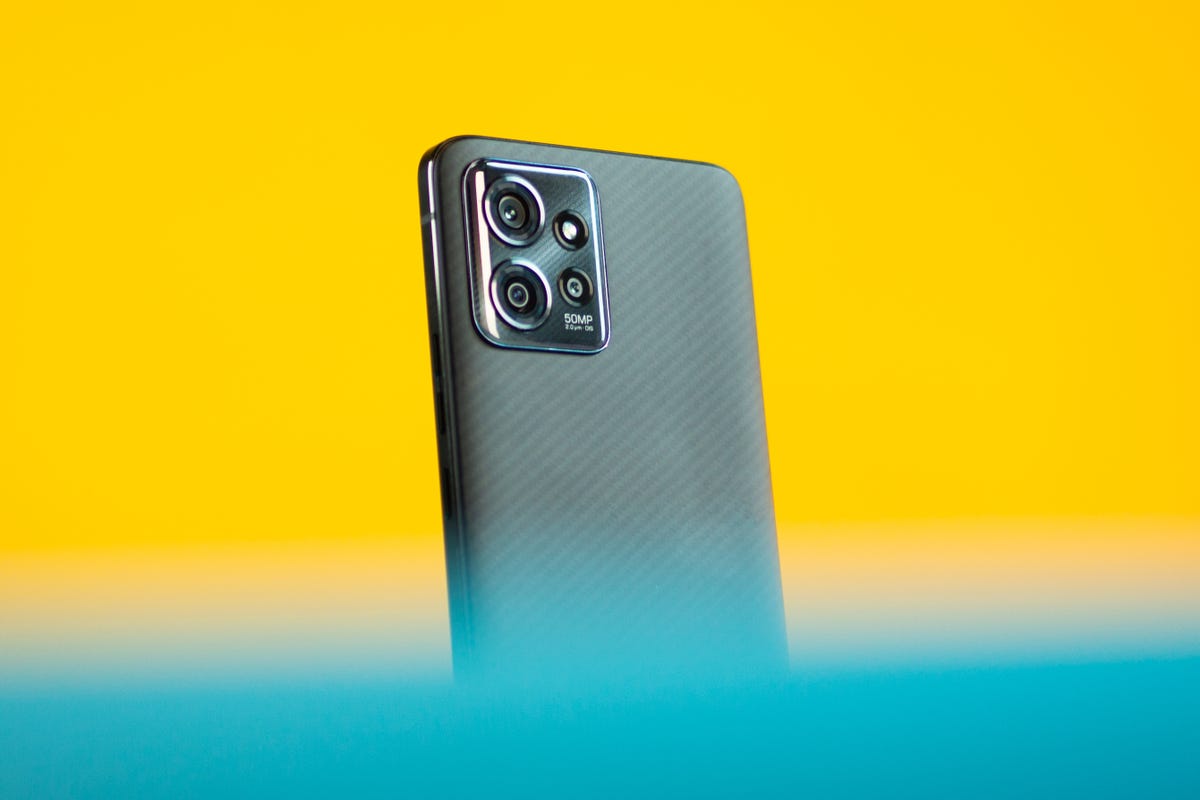
There are two rear cameras: wide and ultrawide.
The ThinkPhone’s cameras, wrap-up
There are two cameras on the back, a 50-megapixel main one and a 32-megapixel ultrawide, which can double as a macro camera. Photos from the ThinkPhone are good, especially when taken under bright lighting. There’s a noticeable step down in quality when photographing in dimmer environments. Check out some of my favorite ThinkPhone photos below.

I took this snap of Peebles the cat with the ThinkPhone’s portrait mode.

I used the ThinkPhone’s night mode to snag this pic at Club Fugazi in San Francisco.

The phone really nailed the colors in this photo.

The main camera captures good detail in bright, even lighting. Take a look at the names of the books.

There are definitely some curiosities at every turn in San Francisco. Details look soft in the fur of the double-raccoon head.

Under mixed lighting, like in this image I took at Luna in San Francisco, the phone did just OK. It doesn’t have the best dynamic range.
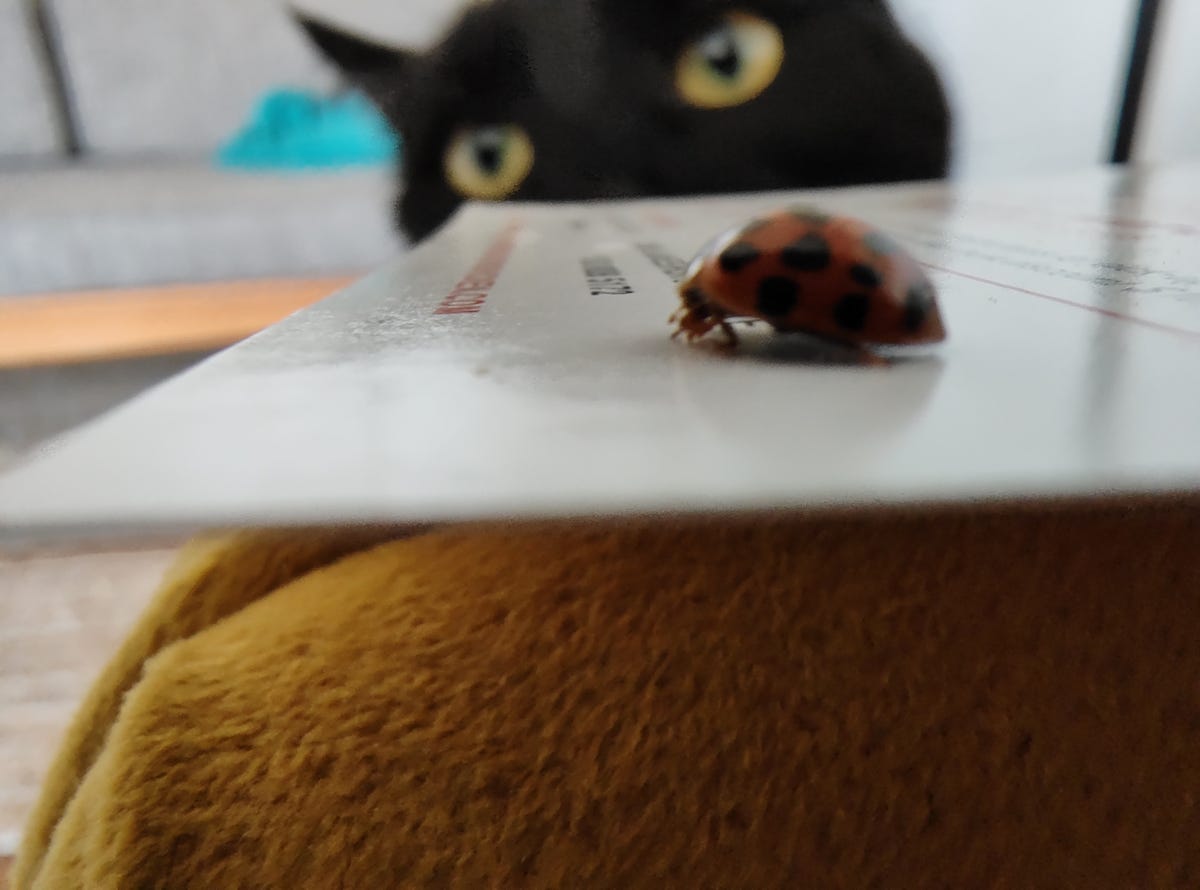
OK, this photo is out of focus. I blame myself. (I was trying to prevent a cat from eating a ladybug.) But the ultrawide lens doubles as a macro lens and allows for close-up shots of small things.

And here’s the same ladybug in focus, sans cat.
The ThinkPhone can record videos up to 8K resolution at 30 frames per second. The image quality in photos is definitely better than videos you record, which is fine as long as filming videos isn’t a priority. But video image quality suffers when recording under low light. Overall, this isn’t meant to be a camera forward device but should be more than capable of capturing everyday snaps.
With everything considered, the Lenovo ThinkPhone by Motorola is a lovely surprise that’s competitive with some of the best Android phones you can buy. While it’s designed to be a business-minded phone, it doesn’t act much differently than a regular consumer phone. It definitely has a lot in common with the more expensive Motorola Edge Plus that came out last month, but the ThinkPhone’s lower price makes it a much better value. It even bests the Edge Plus in our battery and charging tests.

The ThinkPhone brings together Android and Microsoft Windows through Lenovo-specific features.
How we test phones
Every phone tested by CNET’s reviews team was actually used in the real world. We test a phone’s features, play games and take photos. We examine the display to see if it’s bright, sharp and vibrant. We analyze the design and build to see how it is to hold and whether it has an IP-rating for water resistance. We push the processor’s performance to the extremes using both standardized benchmark tools like GeekBench and 3DMark, along with our own anecdotal observations navigating the interface, recording high-resolution videos and playing graphically intense games at high refresh rates.
All the cameras are tested in a variety of conditions from bright sunlight to dark indoor scenes. We try out special features like night mode and portrait mode and compare our findings against similarly priced competing phones. We also check out the battery life by using it daily as well as running a series of battery drain tests.
We take into account additional features like support for 5G, satellite connectivity, fingerprint and face sensors, stylus support, fast charging speeds and foldable displays among others that can be useful. And we balance all of this against the price to give you the verdict on whether that phone, whatever its price is, actually represents good value.

